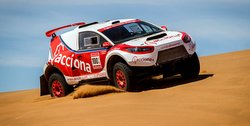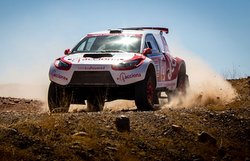A Clean Car Gets Dirty

It’s the most difficult and grueling race for drivers and machines in all of motorsports — the Dakar.
The storied rally, which began as a Paris to Dakar, Senegal, race nearly 40 years ago, moved to South America in 2009 because of security concerns about racing across North Africa.
This year’s race route, which totaled nearly 6,000 miles, wound in and out of Argentina and Bolivia. It traversed mud, rocks, sand dunes and mountain stages of 15,000 feet with near freezing temperatures, followed by desert runs with more than 110 degrees in the shade. It’s about the last place on earth you would expect to see an all-electric car.
But among the 347 cars, bikes, quads and trucks (over 7,000 pounds) that started the race on January 7 in Buenos Aires, the Acciona 100% EcoPowered electric racecar was the only entrant that could brag zero emissions. The purpose-built car is a technology demonstrator project sponsored by Acciona, a Spanish conglomerate in renewable energy and infrastructure.
The company says the purpose of the Acciona Dakar EV is to “reach an optimal balance between electric propulsion technology, powered entirely by batteries, and the unique characteristics of a racing car prepared for an extreme adventure such as the Dakar.”
This is the second time that the Acciona car started the Dakar. Last year it completed the first 10-mile leg in just under two and a half hours. Unfortunately, a navigation system failure prevented the car from following the course correctly, and it was disqualified from the rest of the race.
An Improved Electric Rally Car

Disappointed but determined, the Acciona team of engineers went to work making improvements to the rally car. Last October, it competed in and finished the 2,255-mile International OiLibya Rally of Morocco, a race that’s considered a rehearsal for the Dakar.
Improvements included a 40 percent weight reduction, a more powerful battery pack, four-wheel drive traction and a sequential gearbox to optimize the electric motor’s performance.
At last year’s Dakar, Acciona’s car could travel 125 miles under race conditions on a single charge from a 140-kilowatt-hour lithium-ion battery pack. The upgraded car employs a 150-kilowatt-hour pack that uses the same Panasonic cells as the Tesla Model S. The team says it can now travel 217 miles on a single charge with the new battery. Depending on driving conditions, fuel economy varies between 20 and 45 kilowatt-hours per 62 miles.
Similar to Tesla’s, the Acciona’s pack is made of modules that can be removed when they are not needed for certain stages of the race. Even though the new battery contains more energy, nearly half of the 40 percent weight reduction is attributed to the battery.
The batteries send electrons through the new gearbox to a 300-horsepower synchronous electric motor that can deliver a stump-pulling 516 pound-feet of torque. Top speed is 93 mph.
With the help of a support truck, the team is able to recharge the batteries at various checkpoints in about an hour with a fast-charging system. It’s believed that the fast charger was powered by a biodiesel-powered generator.
Nearly two-feet of suspension travel soaks up rocks, riverbeds and mountain passes along the way. The high-strength, low-weight body is made from carbon fiber, and included this year is a roof of high-yield photovoltaic solar panels to recharge the vehicle’s primary power system (electronic components, navigation, lighting and communication systems).
Almost, But Not Quite

Obviously, with the need to recharge for an hour at checkpoints and the Acciona Dakar EV’s 93 mph top speed could never challenge the mighty factory-backed Peugeot and Mini teams for the win. But driver Ariel Jatón and his co-driver/navigator Gaston Scazzuso were remarkably in 71st place by the end of the 10th day with just one day remaining.
Unfortunately, the following day the team had to bid farewell to the 38th Dakar Rally, but not because of equipment failure.
The Acciona was disqualified from the race due to a delay at the starting line of the special phase of the 10th stage. This delay was due to a necessary battery recharge following the difficult Fiambalá stage, and to ensure the drivers’ recovery after tremendous wear the night before.
In a statement, Jatón said, “We are going home sad for not having completed the 13 stages in their entirety, but we are also proud to have once again left an indelible mark with the only electric car to compete in the Dakar Rally.”
He added that the team would return next year with an electric rally car that is stronger and faster than ever.
I can hardly wait.
By the way, of the 347 entrants at the beginning of the Dakar, only 215 finished the race, which was won by a Peugeot team for the second consecutive year.
